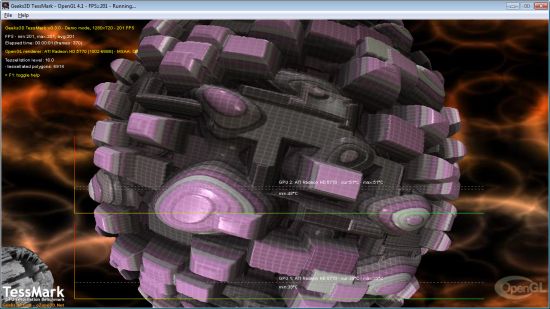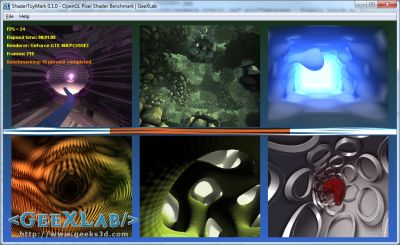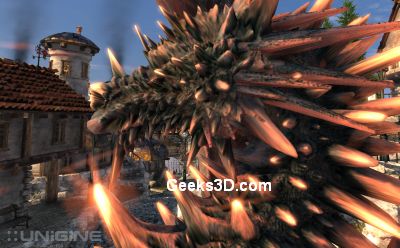ASUS Radeon HD 7770 DirectCU TOP review index
- Page 1 – Overview
- Page 2 – Gallery
- Page 3 – GPU Caps Viewer and GPU-Z Details
- Page 4 – OpenGL Synthetic Benchmarks
- Page 5 – Direct3D Synthetic Benchmarks
- Page 6 – OpenCL Benchmarks
- Page 7 – Gaming Benchmarks
- Page 8 – Power Consumption and Temperature
- Page 9 – Conclusion
4 – ASUS HD 7770 DC TOP OpenGL Synthetic Benchmarks
The testbed:
– CPU: Core i7 960 @ 3.2GHz
– RAM: 4GB DDR3 Corsair Dominator
– Motherboard: GIGABYTE X58-A UD5
– Windows 7 64-bit
– Graphics drivers: Catalyst 12.2 WHQL
– PSU: Thermaltake Thoughpower Grand 850W

4.1 – FurMark 1.9.2 (OpenGL 2)
Settings: Preset 1080 (1920×1080 fullscreen, no AA, no postFX, 60sec, Burn-in mode).
| 3517 points (58 FPS) – GeForce GTX 480 SLI |
| 3457 points (57 FPS) – SAPPHIRE Radeon HD 6970 CrossFire |
| 2463 points (41 FPS) – ASUS ROG MATRIX GTX 580 (GPU@926MHz) |
| 2412 points (40 FPS) – SAPPHIRE Radeon HD 6970 |
| 2398 points (39 FPS) – EVGA GTX 580 Classified Ultra (GPU@900MHz) |
| 2367 points (39 FPS) – MSI GeForce GTX 460 SLI |
| 2145 points (35 FPS) – EVGA GeForce GTX 580 SC |
| 2062 points (34 FPS) – ASUS HD 6950 DC2 |
| 1954 points (32 FPS) – ATI Radeon HD 5870 |
| 1872 points (31 FPS) – ASUS ENGTX570 DirectCU II |
| 1769 points (29 FPS) – EVGA GeForce GTX 480 |
| 1755 points (29 FPS) – EVGA GeForce GTX 295 |
| 1696 points (28 FPS) – ASUS GTX560 Ti DirectCU II |
| 1640 points (27 FPS) – SAPPHIRE Radeon HD 6870 |
| 1527 points (25 FPS) – ASUS GeForce GTX 560 DCII TOP |
| 1468 points (24 FPS) – MSI GeForce GTX 470 |
| 1077 points (17 FPS) – MSI R5770 Hawk |
| 1045 points (17 FPS) – ASUS Radeon HD 7770 DirectCU TOP (Cat 12.2 WHQL) |
| 863 points (14 FPS) – ASUS Radeon HD 6770 DirectCU Silent |
| 740 points (12 FPS) – MSI GeForce GTX 260 |
| 674 points (11 FPS) – ASUS HD 6670 |
| 390 points (6 FPS) – ASUS GeForce GT 440 |
4.2 – TessMark (OpenGL 4)
Hardware tessellation is one of the big features of Direct3D 11 and OpenGL 4 capable graphics cards. TessMark is a new benchmark focused only on the tessellation engine of DX11 class cards. It’s a pure tessellation benchmark, it does not contain complex shader or other heavy texture fetches. TessMark shows an overview of the tessellation engine raw power, that’s all. DX11 specifies that the tessellation factor can vary from 1.0 up tp 64.0. Of course, for tessellation factors like 32 or 64, most of the tessellated triangles are smaller than… a pixel. In those cases, tessellation is useless and in a real world application such as a game, high tessellation factors won’t be used. But in the case of a synthetic benchmark, it’s always instructive to see how cards can handle the whole range of tessellation level.
TessMark 0.3.0 has been used for the test.
Settings: 1920×1080 fullscreen, no AA, 60sec, map set 1.

Rule: The higher the number of points, the faster the card is.
Recent versions of AMD Catalyst drivers have some optimizations related to hardware tessellation (see AMD Catalyst 8.921.2 RC11 for Radeon HD 7900, Big Performance Boost in OpenGL Tessellation).
I didn’t rebenched with recent drivers other radeon cards (HD 5770, HD 6770, HD 6870, HD 6970) so their scores do not reflect current performance in tessellation.
That explains why the HD 7770 exhibits better scores, especially with high tessellation levels (X32, X64).
Tessellation factor 8.0: moderate
| 53863 points (898FPS) – ASUS ROG MATRIX GTX 580 (GPU@926MHz) |
| 53608 points (894FPS) – EVGA GTX 580 Classified Ultra (GPU@900MHz) |
| 53151 (888FPS) – EVGA GTX 580 SC |
| 52188 (872FPS) – ASUS ENGTX580 |
| 48084 – EVGA GeForce GTX 480 |
| 47989 (802FPS) – ASUS GTX 570 DirectCU II |
| 44090 (735FPS) – Sapphire HD 6970 (Cat 11.6), GPU core: 880MHz |
| 39663 points (662 FPS) – ASUS GeForce GTX 560 Ti DirectCU II TOP |
| 38191 – MSI GeForce GTX 470 |
| 37989 points (634 FPS) – ASUS GeForce GTX 560 DCII TOP |
| 30512 – MSI N460GTX Cyclone 768D5 OC |
| 29799 points (497 FPS) – ASUS Radeon HD 7770 DirectCU TOP (Cat 12.2 WHQL) |
| 29633 points (494 FPS) – ASUS Radeon HD 6950 DC2 (GPU @ 810MHz) |
| 27718 (462FPS) – Sapphire HD 6870, GPU core: 1000MHz |
| 27469 (458FPS) – Sapphire HD 6970 (Cat 10.12), GPU core: 880MHz |
| 26223 – ASUS EAH6870 |
| 25480 (425FPS) – ASUS Radeon HD 6950 |
| 24161 (403FPS) – ATI Radeon HD 5870 |
| 23131 (386FPS) – Sapphire HD 6870 |
| 22482 points (375 FPS) – ASUS Radeon HD 6770 DirectCU Silent |
| 20745 – MSI R5770 Hawk |
| 10148 (169 FPS) – ASUS GeForce GT 440 |
| 6583 (110FPS) – ASUS Radeon HD 6670 |
Tessellation factor 16.0: normal
| 36019 points (601FPS) – ASUS ROG MATRIX GTX 580 (GPU@926MHz) |
| 35682 points (595FPS) – EVGA GTX 580 Classified Ultra (GPU@900MHz) |
| 33266 (555FPS) – EVGA GTX 580 SC |
| 32666 (545FPS) – ASUS ENGTX580 |
| 29726 (496FPS) – ASUS GTX 570 DirectCU II |
| 29196 – EVGA GeForce GTX 480 |
| 23594 points (393 FPS) – ASUS GeForce GTX 560 Ti DirectCU II TOP |
| 23316 – MSI GeForce GTX 470 |
| 22296 points (372 FPS) – ASUS GeForce GTX 560 DCII TOP |
| 19398 (323FPS) – Sapphire HD 6970 (Cat 11.6), GPU core: 880MHz |
| 17452 – MSI N460GTX Cyclone 768D5 OC |
| 10337 points (172 FPS) – ASUS Radeon HD 7770 DirectCU TOP (Cat 12.2 WHQL) |
| 9255 (154FPS) – Sapphire HD 6870, GPU core: 1000MHz |
| 8846 points (147 FPS) – ASUS Radeon HD 6950 DC2 (GPU @ 810MHz) |
| 8555 – ASUS EAH6870 |
| 8229 (137FPS) – Sapphire HD 6970 (Cat 10.12), GPU core: 880MHz |
| 8177 (136FPS) – Sapphire HD 6870 |
| 8018 (134FPS) – ATI Radeon HD 5870 |
| 7669 – MSI R5770 Hawk |
| 7384 (123FPS) – ASUS HD 6950 |
| 6345 (106 FPS) – ASUS GeForce GT 440 |
| 3559 (59FPS) – ASUS Radeon HD 6670 |
Tessellation factor 32.0: extreme
| 17176 points (286FPS) – ASUS ROG MATRIX GTX 580 (GPU@926MHz) |
| 17074 points (284FPS) – EVGA GTX 580 Classified Ultra (GPU@900MHz) |
| 15427 (257FPS) – EVGA GTX 580 SC |
| 15128 (252FPS) – ASUS ENGTX580 |
| 13429 (224FPS) – ASUS GTX 570 DirectCU II |
| 13008 – EVGA GeForce GTX 480 |
| 9997 – MSI GeForce GTX 470 |
| 9878 points (165 FPS) – ASUS GeForce GTX 560 Ti DirectCU II TOP |
| 8526 points (142 FPS) – ASUS GeForce GTX 560 DCII TOP |
| 6729 – MSI N460GTX Cyclone 768D5 OC |
| 6356 points (106 FPS) – ASUS Radeon HD 7770 DirectCU TOP (Cat 12.2 WHQL) |
| 3397 (57FPS) – Sapphire HD 6970 (Cat 11.6), GPU core: 880MHz |
| 2826 (47FPS) – ASUS GeForce GT 440 |
| 2299 – ASUS EAH6870 |
| 2246 (38FPS) – Sapphire HD 6870 |
| 2156 (36FPS) – ATI Radeon HD 5870 |
| 2122 (35FPS) – Sapphire HD 6970 (Cat 10.12), GPU core: 880MHz |
| 2159 – MSI R5770 Hawk |
| 1988 points (33 FPS) – ASUS Radeon HD 6950 DC2 (GPU @ 810MHz) |
| 1910 (32FPS) – ASUS HD 6950 |
| 1540 (26FPS) – ASUS Radeon HD 6670 |
Tessellation factor 64.0: insane
| 5671 points (95FPS) – ASUS ROG MATRIX GTX 580 (GPU@926MHz) |
| 5572 points (93FPS) – EVGA GTX 580 Classified Ultra (GPU@900MHz) |
| 4940 (82FPS) – EVGA GTX 580 SC |
| 4840 (81FPS) – ASUS ENGTX580 |
| 4179 (70FPS) – ASUS GTX 570 DirectCU II |
| 3963 – EVGA GeForce GTX 480 |
| 3296 points (55 FPS) – ASUS Radeon HD 7770 DirectCU TOP (Cat 12.2 WHQL) |
| 3169 – MSI GeForce GTX 470 |
| 2895 points (48 FPS) – ASUS GeForce GTX 560 Ti DirectCU II TOP |
| 2485 points (42 FPS) – ASUS GeForce GTX 560 DCII TOP |
| 1959 – MSI N460GTX Cyclone 768D5 OC |
| 868 (15FPS) – ASUS GeForce GT 440 |
| 594 (10FPS) – Sapphire HD 6970 (Cat 11.6), GPU core: 880MHz |
| 585 – ASUS EAH6870 |
| 574 (10FPS) – Sapphire HD 6870 |
| 565 – MSI R5770 Hawk |
| 550 (10FPS) – ATI Radeon HD 5870 |
| 539 (9FPS) – Sapphire HD 6970 (Cat 10.12), GPU core: 880MHz |
| 490 points (9 FPS) – ASUS Radeon HD 6950 DC2 (GPU @ 810MHz) |
| 485 (9FPS) – ASUS HD 6950 |
| 485 (9FPS) – ASUS Radeon HD 6670 |
4.3 – ShaderToyMark (OpenGL 2)
ShaderToyMark 0.3.0 is an OpenGL 2 benchmark, developed with GeeXLab, and focused on pixel shaders only. The pixel shaders are heavily based on math (few texture fetches) and then ShaderToyMark can be seen as a kind of GPU computing benchmark.

Settings: 960×540 windowed, no AA, 60sec
| 368 points (61FPS) – EVGA GTX 580 Classified Ultra (GPU@900MHz) |
| 367 points (61FPS) – ASUS ROG MATRIX GTX 580 (GPU@926MHz) |
| 316 points (52 FPS) – EVGA GTX 580 SC |
| 306 points (51 FPS) – ASUS ENGTX580 |
| 278 points (46 FPS) – ASUS GTX 570 DirectCU II |
| 263 points (43 FPS) – GeForce GTX 480 |
| 249 points (41FPS) – Sapphire HD 6970 (Cat 11.6) |
| 242 points (40 FPS) – ASUS Radeon HD 6950 DC2 (GPU @ 950MHz) |
| 234 points (39FPS) – Sapphire HD 6970 (Cat 10.12) |
| 218 points (36 FPS) – ASUS GeForce GTX 560 Ti DirectCU II TOP |
| 215 points (35 FPS) – ASUS Radeon HD 7770 DirectCU TOP (Cat 12.2 WHQL) |
| 208 points (34FPS) – ASUS HD 6950 |
| 207 points (34 FPS) – ASUS Radeon HD 6950 DC2 (GPU @ 810MHz) |
| 202 points (33 FPS) – ASUS GeForce GTX 560 DCII TOP |
| 189 points (31 FPS) – ATI Radeon HD 5870 |
| 184 points (30 FPS) – ASUS EAH6870 |
| 179 points (29FPS) – Sapphire HD 6870 |
| 156 points (26 FPS) – MSI N460GTX Cyclone |
| 122 points (20 FPS) – MSI R5770 Hawk (Cat 12.2 WHQL) |
| 64 points (10 FPS) – ASUS Radeon HD 6670 |
| 55 points (9FPS) – ASUS GeForce GT 440 |
| 46 points (7 FPS) – GeForce 9800 GTX |
| 36 points (6 FPS) – EVGA GTX 280 |
| 33 points (5 FPS) – GeForce GTX 260 |
Settings: 1920×1080 fullscreen, no AA, 60sec
| 173 points (28 FPS) – SAPPHIRE Radeon HD 6970 CrossFire (GPU@880MHz) |
| 129 points (21FPS) – EVGA GTX 580 Classified Ultra (GPU@900MHz) |
| 109 points (18 FPS) – MSI GeForce GTX 460 Cyclone SLI (AFR1 mode) |
| 88 points (14 FPS) – SAPPHIRE Radeon HD 6970 (GPU@880MHz) |
| 81 points (13 FPS) – ASUS GeForce GTX 590 (GPU@617MHz) |
| 72 points (12 FPS) – ASUS Radeon HD 7770 DirectCU TOP (Cat 12.2 WHQL) |
| 57 points (9 FPS) – SAPPHIRE Radeon HD 6870 |
| 39 points (6 FPS) – ASUS Radeon HD 6770 DirectCU Silent |
| 39 points (6 FPS) – MSI R5770 Hawk (Cat 12.2 WHQL) |
4.4 Unigine Heaven (OpenGL 4)
For this last OpenGL test, I used Ungine Heaven 2.1, one of the standard Direct3D / OpenGL synthetic benchmark.

Settings: 1920×1080 fullscreen, OpenGL rendering, tessellation: normal, shaders: high, AA: 4X, 16X anisotropic filtering.
| 53.6 FPS, Scores: 1350 – EVGA GTX 580 Classified Ultra (GPU@900MHz) |
| 52.7 FPS, Scores: 1328 – ASUS ROG MATRIX GTX 580 (GPU@926MHz) |
| 48.6 FPS, Scores: 1224 – EVGA GTX 580 SC |
| 46.4 FPS, Scores: 1168 – ASUS ENGTX580 |
| 40.8 FPS, Scores: 1029 – ASUS GTX 570 DirectCU II |
| 38.7 FPS, Scores: 974 – EVGA GeForce GTX 480 |
| 35.8 FPS, Scores: 901 – ASUS GeForce GTX 560 Ti DirectCU II TOP |
| 33.3 FPS, Scores: 838 – ASUS GeForce GTX 560 DC2 TOP |
| 28 FPS, Scores: 704 – SAPPHIRE Radeon HD 6970 (Cat11.6) |
| 24.7 FPS, Scores: 622 – SAPPHIRE Radeon HD 6970 (Cat10.12) |
| 24.5 FPS, Scores: 617 – MSI N460GTX Cyclone 768D5 OC |
| 24.2 FPS, Scores: 609 – ASUS Radeon HD 6950 DC2 |
| 21.6 FPS, Scores: 544 – ASUS Radeon HD 6950 |
| 20.1 FPS Scores: 506 – ASUS Radeon HD 7770 DirectCU TOP (Cat 12.2 WHQL) |
| 15.9 FPS, Scores: 400 – ATI Radeon HD 5870 |
| 14.4 FPS, Scores: 363 – MSI R5770 Hawk (Cat 12.2 WHQL) |
| 13.6 FPS, Scores: 342 – ASUS EAH6870 |
| 13.5 FPS, Scores: 339 – SAPPHIRE HD6870 |
| 9.5 FPS, Scores: 240 – ASUS GeForce GT 440 |
| 8.9 FPS, Scores: 224 – ASUS Radeon HD 6670 |
ASUS Radeon HD 7770 DirectCU TOP review index
nice review!!! thanks !!!!
That graphic card has shader clock. It is new. That shader clock is 2000MHz with overclocked. But that graphic card has negative. The memory is 1GB. It is not bad.
THIS CARD IS GREAT!
Is it DirectX 11 compatible?
Dont know SO much about graphic cards but if it is i’ll buy it
Oh nevermind found that it was it on page 5 haha